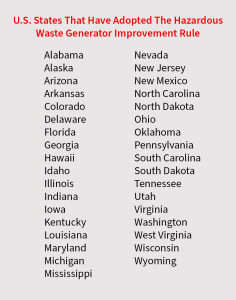
/ IN THIS BLOG
01 / State-by-State Update
Since its finalization four years ago, 35 states have adopted the Hazardous Waste Generator Improvements Rule(See sidebar). So have Puerto Rico, American Samoa, the Northern Mariana Islands, and Federal Tribal territories (See map).
The rule went into effect on May 30, 2017 and was the first major effort in 35 years on the part of the EPA to amend its rules about hazardous waste disposal.
Its purpose was to simplify various regulations for hazardous waste generators, making such rules easier to understand.
More specifically, the agency wanted to provide greater flexibility for hazardous waste management, so set about reorganizing and simplifying various regulations to make them more flexible and user-friendly.
The hope was (and remains) that hazardous waste might be managed more economically, thereby increasing compliance.
02 / Understanding the Holdouts
States that have yet to adopt the rule tend to be those with relatively strict environmental laws and regulations, thereby taking additional time to reconcile the EPA’s “more flexible and adaptable” rules with those of their own. New York and California are prime examples.
As we’ve counseled before in this space, US state environmental laws tend to be more restrictive than their federal counterparts. So, as in all things concerning hazardous waste disposal, it’s crucial to get expert advice.
03 / What's Easier vs. What's Harder
By the EPA’s own account in 2017, the simplified rules feature more than 60 revisions and new provisions that would impact between 424,000 and 677,000 hazardous waste generator locations, affecting virtually all US industries as well as many other commercial and governmental enterprises.
The agency also used the opportunity to toughen certain regulations that would close perceived gaps in environmental protection. For example, the rule adds language specifying:
Hazardous waste determination must be “accurate” and done at the point of generation prior to any dilution, mixing, or other alteration.
If the properties of a hazardous waste are somehow changed during its management, then the RCRA classification must also be reassessed.
SQGs and LQGs must identify all applicable EPA hazardous waste codes and so mark containers prior to shipping.
So again: it’s crucial to get expert advice.
04 / What were the main changes?
- It allows very small quantity generators (VSQGs) producing 220 pounds or less of hazardous waste per month to ship their waste to a large quantity generator (LQG) under the control of the same company. According to the EPA, this can reduce a company’s operating costs and environmental liability, encourage greater recycling efforts, and reduce the amount of VSQG hazardous waste being sent to municipal solid waste landfills.
- Instead of triggering more stringent generator regulations, it will allow a small quantity generator (SQG) or a very small quantity generator (VSQG) to keep its present generator status in the case of a non-routine event. According to the EPA, this can provide relief if, for example, a company generates an atypical amount of hazardous waste in a single month, as in the case of a product recall.
- It mandates that additional information be provided about the dangers posed by a hazardous waste when it’s being accumulated onsite; as well as amending regulations about communicating such risks to workers, waste handlers, and emergency responders.
- It finalizes a requirement for SQGs to re-notify the EPA of their generator status every four years, with the first renotification requirement beginning September 1, 2021. The purpose of this requirement is to improve data accuracy for future compliance and oversight.
05 / The public's reaction
Nine industry groups challenged the rule in the Court of Appeals for the D.C. Circuit as “unlawful, arbitrary, capricious, an abuse of discretion, or not otherwise in accordance with law.” Among them were the:
American Chemistry Council
American Forest & Paper Association
American Iron and Steel Institute
American Petroleum Institute
American Wood Council
Association Connecting Electronics Industries
Motor & Equipment Manufacturers Association
National Oilseed Processors Association
Society of Chemical Manufacturers & Affiliates
In response to public input after its initial proposal, the EPA made several significant changes to the rule relative to how it was originally conceived. Some of the most important were:
Hazardous waste generators needn’t document all determinations that a waste is not a hazardous waste nor maintain such documentation in its record.
Hazardous waste generators needn’t label containers and tanks of hazardous waste with a description of the contents, except for the words “Hazardous Waste,” a description of the dangers posed by the contents, and the date the accumulation started.
The timeframe for an event to be considered “episodic” is 60 days.
The timeframe for SQG re-notification is changed to every four years starting in 2021 and to September 1 of the year such re-notifications are required.
06 / Our best advice
First and foremost, you don’t want to run afoul of any extant hazardous waste mandates in your state. So, make sure that your state is one of the 35 that’s onboard with the Hazardous Waste Generator Improvements Rule before you make any changes to your hazardous waste management in reaction to it.
Hazardous waste management regulations are plentiful, evolving, and challenging to track. Complicating matters, such regulations tend to come from more than one government agency at haphazard intervals. And ignoring or misunderstanding them can subject you to financial and even criminal consequences.
So don’t go it alone. Get expert advice here. Or phone 866.315.8116
And thank you for reading our blog!
Robert Losurdo
President, COO









